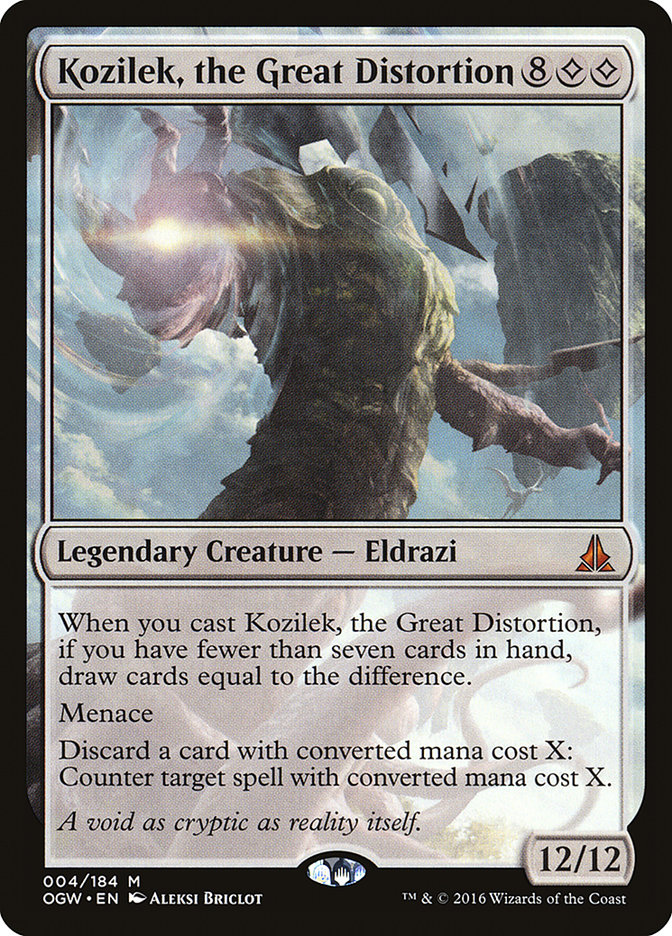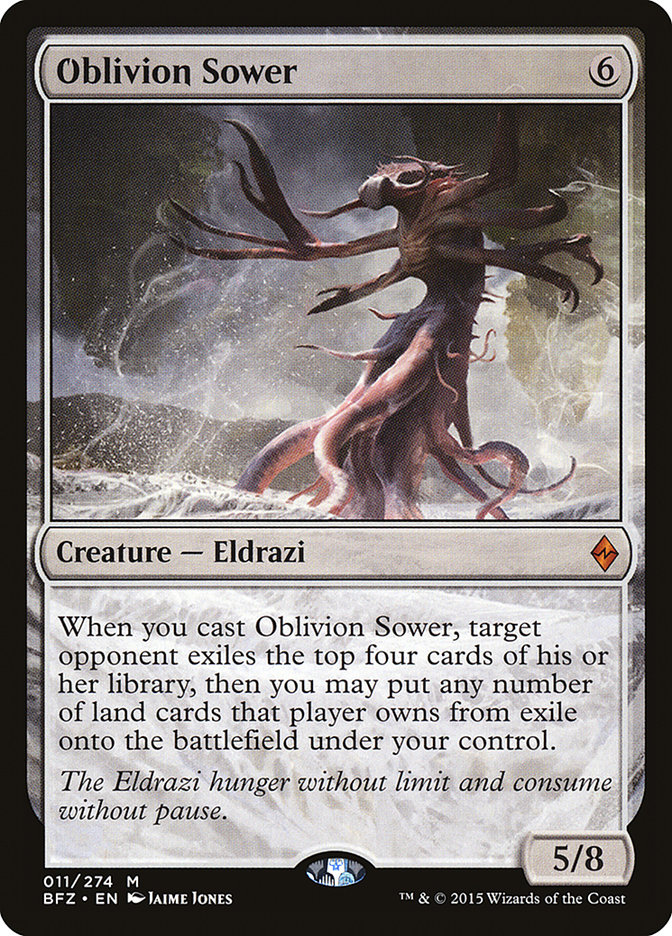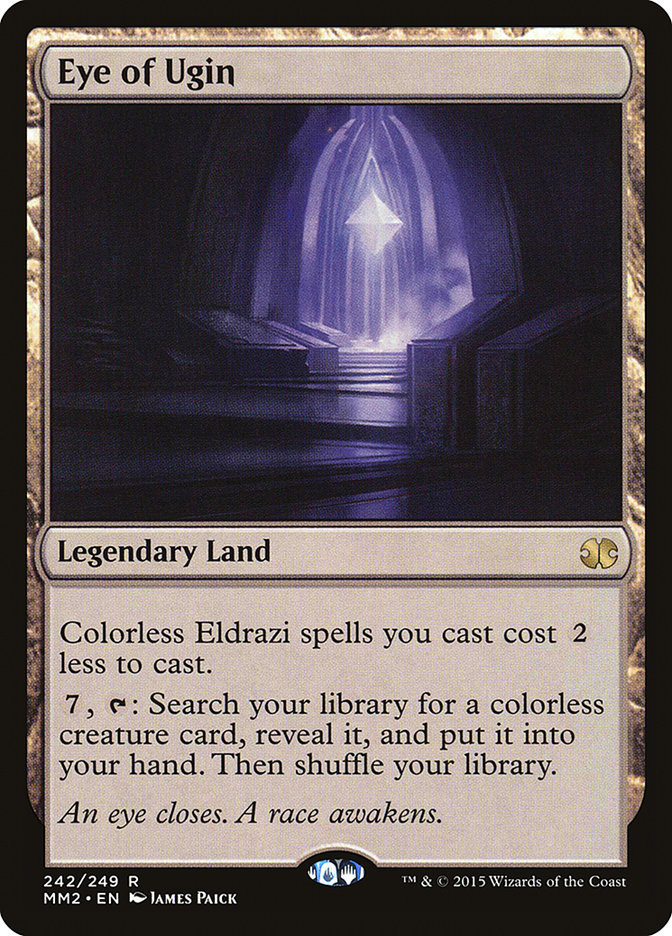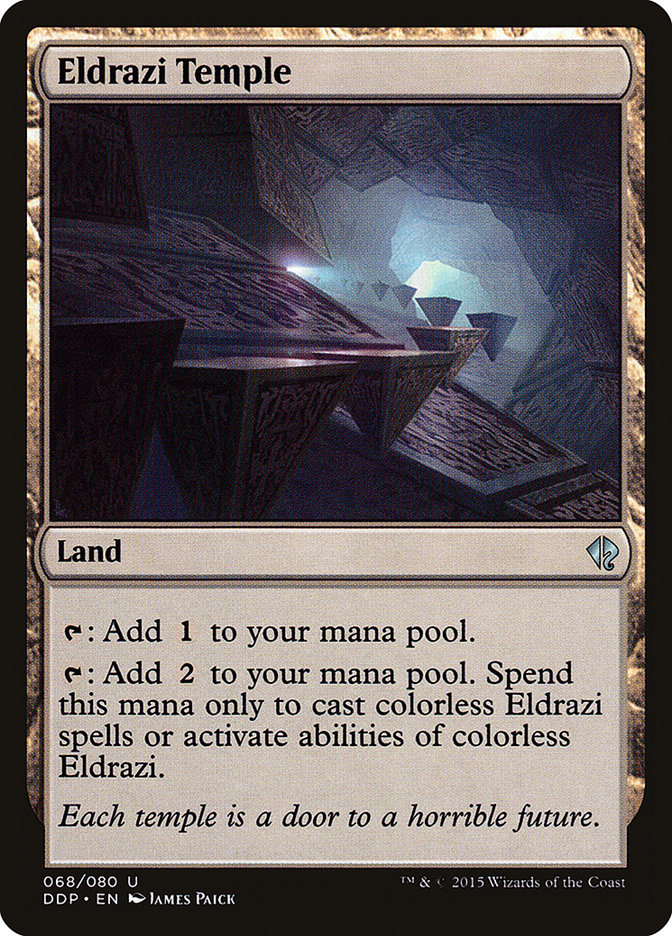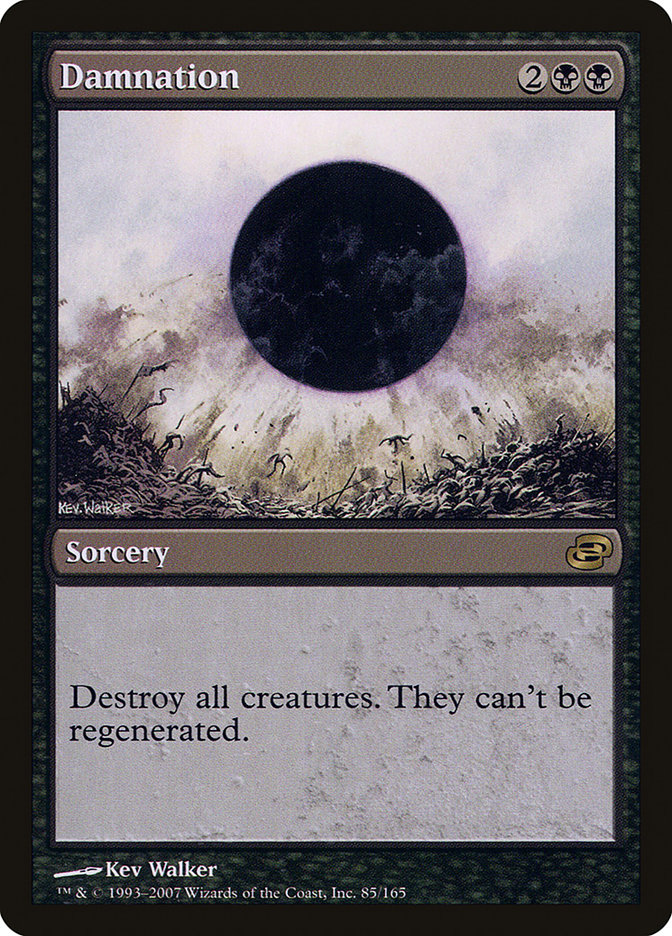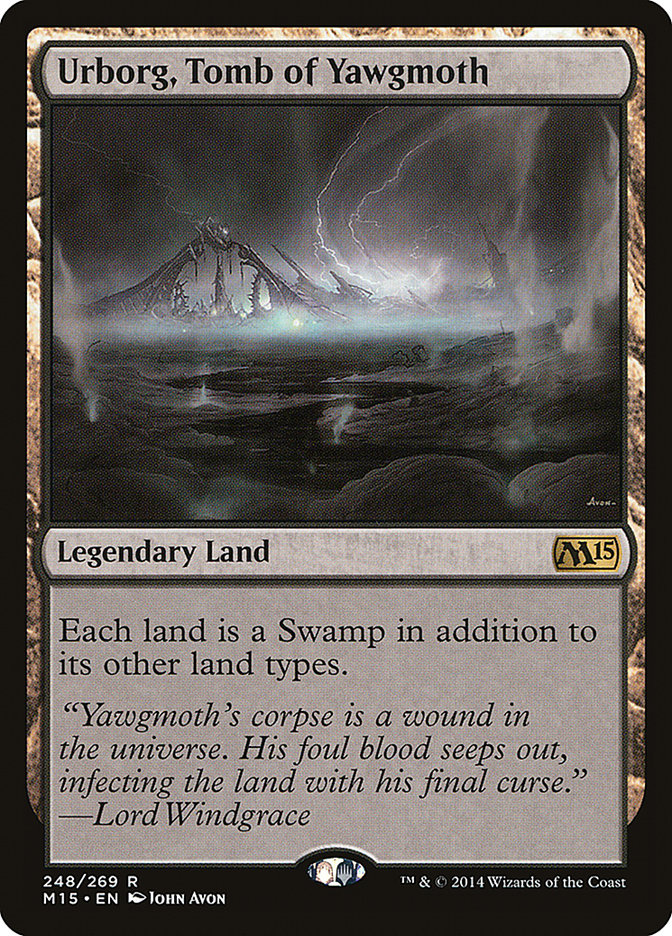Let’s talk about Kozilek, the Great Distortion.
As Patrick Chapin talked about on Monday, the question isn’t whether if Kozilek is good, but rather how to use it. We should start by taking a look at the newest incarnation of the powerful musketeer.
The Great Distortion is incredibly unique as far as powerful expensive cards go. While annihilator was a much more brute force variety of mechanic, the new Eldrazi are a little more subtle. Ulamog, the Ceasless Hunger’s immediate impact on the battlefield is obvious, but from there its inflated stats are more or less just that – until its trigger puts an opponent’s entire library in exile.
While Kozilek initially does much less to the battlefield than Ulamog, drawing upwards of seven cards is almost unheard of for a pay-off for a ramp target. Further, we get to draw the cards regardless of resolution. Once Kozilek is in play, its “inflated stats” are just okay – a 12/12 menace is certainly serviceable for finishing the game by itself. Menace isn’t exactly on the same level as trample or flying in terms of evasion, but it still helps to get the job done in a relatively timely manner.
What really matters, however, is Kozilek’s last text box. A one sided Timetwister that feeds into free counterspells? I think it’s fair to say that a properly constructed deck should almost always be able to leverage Kozilek into a game win should the battlefield be relatively stable before his arrival.
Kozilek, the Great Distortion demands a ton of consideration in deckbuilding, but the pay-off is astronomical. First of all, just to cast Kozilek, it requires actual colorless mana – the new Wastes mechanic. Second, as noted a moment ago, our deck by design needs a variety of common casting costs and an overload of the most important – functionally quite similar to how Counterbalance plays in Legacy construction.
The larger the variety in played converted mana costs, the generally less effective Kozilek will prove to be. Again, the Great Distortion also has a severely more limited immediate effect on the battlefield than Ulamog. When all of this is put into consideration, I think it far more likely that Kozilek will play a more vital role than Modern than in Standard – where it is more likely to be a singleton target for Sanctum of Ugin in Eldrazi Ramp.
I attempted a brief foray into the world of Modern Eldrazi, and while I didn’t quite hit the mark, Magic Online has made a lot of progress since.
For those that haven’t seen any of the Modern Eldrazi lists that are doing well on Magic Online: Their main engine involves Blight Herder and Oblivion Sower, which are powered up by Eye of Ugin and Eldrazi Temple.
It is much easier to process cards in Modern, particularly with Relic of Progenitus, Nihil Spellbomb, and Bojuka Bog. Blight Herder is an impressively threatening card in Modern, especially when it costs as little as three mana. A 4/5 is no slouch, and when it brings a legion of tokens despite falling prey to a blue spell, that is both a lot of pressure for an opponent to contend with, and a huge surge in chump blockers and mana.
While Blight Herder may be powerful, Oblivion Sower is the really interesting part of the Eldrazi deck. It is not exactly intuitive from a simple first reading of the card, but Oblivion Sower’s trigger will take all exiled land cards from an opponent, not just up to four resulting from its trigger. This means that every fetchland or Ghost Quarter an opponent has used and which has entered exile from a Relic of Progenitus will be under your control after the trigger. While it may appear difficult to use all of the variety of lands an opponent could be sporting in Modern, that is not the case when we’re already so incentivized to play Urborg, Tomb of Yawgmoth, which makes Eye of Ugin good for producing three Eldrazi mana.
What this often results in is any Oblivion Sower creating a huge surge in your mana output, which jump starts the classic Eye of Ugin engine that buries your opponent.
It would be reasonable to ask why the Eldrazi Ramp Engine would be appealing over R/G Tron or Amulet Bloom. The answer is that Modern Eldrazi is forced to play far less colorless lands and its threats are functionally much cheaper and are resistant to counter magic. This gives the deck the ability to play a far more standardized earlygame and go so far as to include normal interactive elements like discard and removal in addition to their Relics and other exiling effects.
The fact of the matter is that no one has even come close to “figuring out” this archetype. Modern Eldrazi is absolutely in its infancy and is subject to huge impact by any printings in Oath of the Gatewatch: including Kozilek, the Great Distortion.
Eye of Ugin and Eldrazi Temple are such fundamentally powerful cards for anything that costs less than fifteen mana, however, that as players we are forced to take a critical look at anything with the Eldrazi sub-type.
When so many Modern decks have little interest in flooding the battlefield with creatures and their mana costs are so targeted towards efficiency like other Eternal formats, Kozilek, the Great Distortion has the potential to be the absolute best pay-off spell in the format.
Let’s start looking at some decks shall we?
Creatures (13)
Lands (24)
Spells (23)

This is about as baseline as we are capable of getting and what the Magic Online community has generally concluded is the foundation for how to build Eldrazi decks. The further we are willing to move away from Wasteland Strangler, the less it is necessary to overload on exiling effects, which I think is something we are interested in moving forward with now that Kozilek is in the discussion.
For that matter, Kozilek encourages embracing more of a “pure ramp” strategy, which I’ll go further into discussing shortly.
Dismember is a spell that I think will fit into this archetype well moving forward. A three casting cost removal spell that is effective against Splinter Twin whether cast or discarded to Kozilek is a great inclusion.
There have been some fringe inclusions of cards like All is Dust and other sweepers, but Damnation is a great tool against aggressive strategies where Eldrazi will ultimately have inevitability. It is especially important that we are capable of dealing with wide creature strategies as Kozilek, the Great Distortion is so incredibly effective at closing the door on a stable board. In the past strategies similar to this have been quite poor at handling decks like Burn, but Kozilek is almost guaranteed to lock Burn and similar decks out of the game upon resolution.
Of course, Damnation is also a four mana cost spell. Almost every non-creature centric deck in Modern has a few high-impact four-cost spells that we are interested in locking out.
It’s also worth noting that Oblivion Sower is capable of stopping Primeval Titans and Hive Minds.
Over the holiday break, I had a little bit of fun exploring super-fringe land destruction strategies. As a result I’ve been playing Smallpox lately. Smallpox also works well in conjunction with Lingering Souls, which is another powerful card for stalling and prolonging games.
Creatures (11)
Lands (24)
Spells (25)

While there’s a bit of nombo with Path to Exile and Smallpox, we are much less interested in trying to keep our opponents off mana permanently than normal Pox decks. Rather, the goal is simply to trade resources quickly and keep our opponents off big threats. In addition to the synergy with Flagstones, Smallpox is effective at livening up all of the extra legendary lands we have lying around. Path to Exile is also excellent insurance against creature combos and is another exile effect for processing.
This deck is taking Eldrazi Ramp in a much more controlling direction with effective removal, and Lingering Souls and Smallpox to buy time before our heavy hitters.
While everyone has mostly been building base-black Eldrazi decks that hinge on their use of discard, what if we tried to make more of an all-out ramp deck similar to G/R Tron?
Creatures (14)
- 2 Spellskite
- 4 Oblivion Sower
- 4 Blight Herder
- 1 Ulamog, the Ceaseless Hunger
- 3 Kozilek, the Great Distortion
Lands (21)
Spells (25)

While we want to be base green in a similar manner to Tron, the fact that Urborg, Tomb of Yawgmoth is already so good in the deck naturally pushes us towards black. As a result, we get access to Abrupt Decay, which is an awesome anti Splinter Twin tool.
Ancient Stirrings is phenomenal in this deck. Not only does it grab key lands, but it also filters towards Relics to power up our Processors, and finds our threats. Yes, this is exactly the range of applications that it has in Tron, but since our threats are so much cheaper, they can be found and deployed early quite easily without having to jump through the first hoop of establishing an elaborate mana engine.
I’m not actually convinced Sylvan Scrying is all that great or much better than Expedition Map here, which is amusing, but it is a two mana cost spell, which is fairly relevant.
Speaking of converted mana costs, due to how lean and efficient we want our deck to be – including the inclusion of the Chromatic cantrips–we have a much less diverse suite for Kozilek. It may be a real issue to not have access to a number of threes and fours to power up the Great Distortion.
That being said, I like the look of this deck. As I just mentioned, Ancient Stirrings is a real work horse here, and the payoff of Kozilek is so absurdly high that I could see this being the new face of G/R Tron moving towards Oath of the Gatewatch.
It’s always easy to look towards Standard for receiving the biggest shake up when a new set comes out, but in the case of Kozilek, I think the answer is that Modern is in store for a change.
What do you think about our newest Eldrazi overlord?

